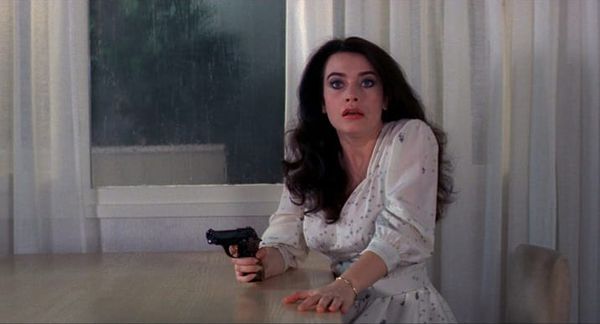Eye For Film >> Movies >> Tenebrae (1982) Film Review

Generally - and rightly - regarded as one of Italian horror maestro Dario Argento's finest films, Tenebrae marked the director's return to the giallo genre which he implicitly popularised, after his detour into supernatural gothic horror with Suspiria and Inferno. Based on the filmmaker’s own experiences of an unhinged fanatic obsessed with his work, Tenebrae follows the story of American mystery-thriller novelist Peter Neal (Anthony Franciosa), whose arrival in Rome to promote his latest title coincides with a series of violent murders – the perpetrator of which claims to have been inspired by Neal’s latest book. When the author himself begins to receive death threats from the killer he must use his literary know-how to snare the slasher before he becomes the next victim.
Tenebrae was added to the Video Nasty list and banned on video in the UK until 1999, when it was released with severe cuts. The film was finally passed uncut and uncensored in 2002. Now, this definitive version of Tenebrae comes to DVD and (for the first time in the UK) Blu-ray, courtesy of Arrow Video, and boasts a brand new HD restoration which perfectly showcases Argento’s inimitable style and sado-chic.

Despite its title (which is Latin for ‘darkness/shadows’), Tenebrae is a bright, stark and strikingly lit film (cinematographer Luciano Tovoli also lensed Argento’s candy-coloured Suspiria and forthcoming Dracula 3D) – and the new HD restoration really helps it pop off the screen like you’ve never seen before.
Unfolding as a cunningly reflexive critique of the Italian giallo, as well as Dario Argento’s own distinct body of work, Tenebrae directly addresses the accusations of misogyny often hurled at the director throughout his opulent and bloodily-hewn career. Containing some of his most iconic imagery and providing a commentary on the nature of violence in cinema and literature, Tenebrae also sees Argento actively examining some of his most recurring themes and preoccupations with a savage precision, as well as namedropping some of his literary influences such as Arthur Conan Doyle and Agatha Christie.
Freudian psychology, sexual deviancy, repressed trauma, voyeurism/spectatorship and the sexualisation/fetishisation of violence and death are all on bold display throughout this twisted story which is also pierced with a slew of heavily stylised murder set-pieces, the likes of which are usually associated with the director’s cinema.
Further highlighting Argento’s stylish and reflexive approach to depicting violence, a number of carefully orchestrated moments work to lift us out of the narrative to objectively consider what is happening on screen. Not only are the audience placed firmly in the role of ‘voyeur’, but we’re also made to consider this very notion and our role as active spectators. Argento works to purposefully detach us from the story with several technically impressive camera shots – including one where the camera scales a victim’s house in one seamless take, navigating walls and floating over the roof, peering in through windows. As dazzling as it is, the shot doesn’t further the narrative, nor does it represent anyone’s point of view; it exists simply to remove us from the ‘reality’ of the film and because Argento enjoys showcasing his technical prowess.
At other times, his more usual approach of utilising the camera to show us events from the murderer’s point of view are in full effect. The result is a dizzying melee of artistically framed shots which alternate between disrupting the narrative and thrusting us deep into the very midst of the ensuing onscreen mayhem. It’s also no coincidence that many of the victims gaze, almost longingly, into the camera and directly at us, not only implying our involvement in their violent deaths, but also serving as a reminder that they’re happening for our entertainment.
Despite all the slyly subversive reflexivity, Tenebrae also functions as an engrossing murder mystery. Typical of the genre, it boasts shoals of red herrings with various motives, a psychologically fractured killer sporting black leather gloves and a penchant for hacking up sexually liberated women, and the story twists and turns delivering a slew of shocking revelations that enhance the mystery and thicken the plot as Argento toys with audience/character perception and perspective.
As mentioned, the look of the film is really rather striking and the Rome depicted in it is not the Rome usually portrayed in cinema; no landmarks or typical baroque architecture are on display. Instead it is presented as an anonymous, nearly futuristic city, devoid of character and full of eerie, well-lit and sparsely peopled streets and squares which adds to the unusual, coldly detached tone of proceedings; as does the bombastic electronic score by ex-Goblin members Claudio Simonetti, Fabio Pignatelli and Elsa Morante.
Reviewed on: 28 Jul 2011



















